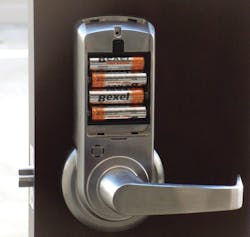Back Page, March 2021
10 Years Ago
An automotive article asked, “Time To Trade-in your Transponder Programmer?” Even in 2011, multiple vehicle transponder programming devices were available from a number of different companies. Steve Kaufman wrote about one consumer’s bad experience with scammer locksmiths, still an ongoing problem today. Emtek introduced its electronic keypad locks — no key required. Master Lock also introduced keypad locks for residences. Jerry Levine wrote about trends in electronic locks, including the Arrow Revolution and the Schlage AD-Series. Ten years ago, touchscreens were considered high tech, and no one used a smartphone to open a door. Securitron’s off-the-grid solar power supply (BPSS) was introduced. Tim O’Leary reported on the newest smart access control credentials — aptiQ smart cards from Schlage. Tom Gillespie wrote about opportunities for servicing safe-deposit locks.
20 Years Ago
Jerry Levine introduced us to the Ilco Unican Safelock 515 Convert-A-Bolt. Tim O’Leary explained what stand-alone access control systems can do and why locksmiths should install them. Jim Glazier detailed which cameras you should have to be an investigative locksmith. Mike Ferrill took a vacation in Hawaii and interviewed hotel-maintenance officials about the features of their hotel security system. Dick Zunkel showed uses for magnetic locks having a delayed-egress feature. Tiny serviced the locks on a 1999 Ford Ranger. Of special interest was the special Ford Ranger tire-lock key system. Jerry Levine introduced conversion plates for installation of DORMA door closers when replacing other brands. Jerry Levine also explained how LAB pin kits closely match the original manufacturer pins. An Auto Security Products pin kit selector was published showing which ASP pin key to use for various popular car models. Charles Stevenson continued his series on components in a safe lock. Billy Edwards answered the important question: "Who owns a masterkey system?”
Powering Stand-Alone Electromechanical Locks
Read the full article from March 2011 at www.locksmithledger.com/10223430
Stand-alone electromechanical locks require battery power to operate. Most network-capable, stand-alone electromechanical locks have a battery-condition indicator. As the battery in a networked lock begins to reach replacement level, the software typically notifies you of this condition. This simplifies the process of battery replacement.
However, for non-networked locks, the story is different. The average lock manufacturer designs locks that have sufficient battery power for at least one year plus a margin of safety. Most lock manufacturers recommend replacing their batteries once per year.
Note: Some lock manufacturers list the number of openings or cycles an average electromechanical lock can operate during the life expectancy of the batteries. Others indicate the number of years of operation when using one set of batteries.
How long will the batteries actually last in a particular lock installed into a door? This can be determined by figuring out the number of times access is gained through the door. This can be the actual number (or a rough guess) of how many times a year a particular lock will operate. Counters can be installed at the top of the door for a given period. Then, multiply the number of days, weeks, etc. to come to one year.
Another option is to use a set of calculations to determine the average use. High traffic can be considered 100–200 openings per day; medium traffic can be considered 50 openings per day and low traffic (residential or limited operation) can be considered 25 openings per day.
To round out the traffic-level numbers, the high, medium and low openings are for 365 days. Therefore, a 100-opening high-traffic door will have about 36,500–73,000 openings in a year. The medium traffic door will have 18,250, and the low-traffic door will have 9,125.
Using these numbers is a good way to gain an idea of the time a set of batteries will last in a particular lock after you know an average number of cycles.
AA alkaline batteries are the recommended battery power for most electromechanical locks. Alkaline batteries, developed in the 1950s, have a higher energy density and a longer shelf life than the standard or heavy-duty batteries.
Lithium batteries aren’t recommended for use with electromechanical door locks for two reasons. Their life expectancy doesn’t follow a calculable pattern, removing any time frame for usable battery life. They operate and then stop almost immediately, providing no room for gauging replacement time or knowing when the batteries are losing charge. Another reason is that lithium batteries can have too rapid a discharge, resulting in overheating, rupture and explosion.
